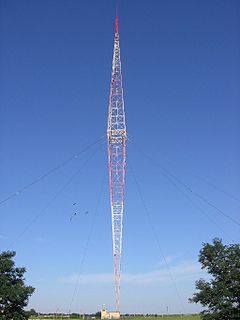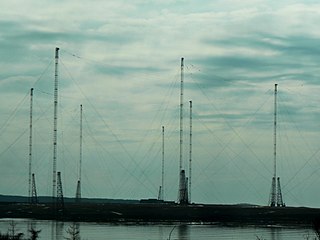
The Lakihegy Tower is a 314-metre-high (1,031 ft) radio mast at Szigetszentmiklós-Lakihegy in Hungary. The Blaw-Knox type tower was built in 1933 and was one of Europe's tallest structures at the time of construction. It was designed to provide broadcast coverage for Hungary with a 120 kW transmitter. It was built for the purpose of transmitting the radio station "Budapest I.", which it served until 1977.
Haʻikū Valley is an amphitheater-shaped valley on the windward side of the Koʻolau Range behind Kāneʻohe, Oʻahu in the Hawaiian Islands. The valley was the site of a United States Navy radio transmitting station and is part of the route of Hawaii's Interstate H-3.

WTCN-CA is a Class A, MyNetworkTV-affiliated television station licensed to Palm Beach, Florida, United States, serving the Gold and Treasure Coasts of South Florida. It broadcasts a low-powered high definition digital signal on virtual and UHF channel 43 from a transmitter in unincorporated Martin County on the Jonathan Dickinson State Park boundary. On cable, the station can be seen on Comcast Xfinity channel 15 and in high definition on digital channel 430.
Montana was a paddle steamer that was wrecked off the north coast of Bermuda on 30 December 1863.
WEFT Champaign 90.1FM is a listener-supported community radio station in Champaign, Illinois, founded in 1981 and owned by Prairie Air, Inc., a not-for-profit corporation. WEFT typically broadcasts 24 hours per day and 7 days per week. It has a wide range of programming, including music from a range of genres, local and nationally produced public affairs programming, live music, spoken word, and more. WEFT's mission is to be "an accessible, responsible, and responsive radio alternative, serving the diverse communities of radio listeners in East-Central Illinois".

The Cape Race LORAN-C transmitter is a LORAN-C transmitter at Cape Race, Newfoundland and Labrador, on Canada's eastern seaboard.
Angissoq LORAN-C transmitter was a LORAN-C transmitter at Nanortalik-Angissoq, Greenland of GRI 7930, 59°59'18"N, 45°10'24" W. Angissoq LORAN-C transmitter had a transmission power of 1000 kilowatts.
It used until July 27, 1964 a 1350 ft tall mast radiator, which was built in 1963. On July 27, 1964 this tower collapsed as a result of a fatigue failure of an eyebolt head in a compression cone insulator on a structural guy.
The collapsed tower was replaced afterwards by a 704 ft tall mast radiator.
On December 31, 1994 the transmitter was shut down. The tower was dismantled.
Bø LORAN-C transmitter is a LORAN-C transmitter at Bø, Norway. Bø LORAN-C transmitter is the X-ray secondary station of the Ejde chain and the master station of the Bø chain. The transmission power of Bø LORAN-C transmitter is 400 kW.
LORAN-C transmitter Ejde is the Master station of the Ejde LORAN-C Chain.
It uses a transmission power of 400 kW.
Ejde LORAN-C transmitter, situated near Eiði at. Ejde LORAN-C transmitter uses as antenna a 190.5 metre tall mast radiator.
In 1962 the mast of LORAN-C transmitter Ejde collapsed as a result of a slipping guy.

LORAN-C transmitter Malone was the master station of the Southeast U.S. LORAN-C Chain and the Whiskey Secondary of the Great Lakes chain. It used a transmission power of 800 kW for both chains.
Coast Guard LORAN-C Station Estartit was the Zulu secondary station of the Mediterrean Sea LORAN-C Chain.
It used a transmission power of 165 kW.
Estartit LORAN-C transmitter, was situated near Estartit at. Estartit LORAN-C transmitter used as antenna a 190.5 metre tall mast radiator.
LORAN-C transmitter Jupiter is the Yankee secondary station of the Southeast U.S. LORAN-C Chain. It uses a transmission power of 165 kW.
Jupiter LORAN-C transmitter, situated at Jupiter, Florida at 27°1'59" N, 80°6'53" W. Jupiter LORAN-C transmitter uses as antenna a 190.5 metres (625 ft) tall mast radiator, which was built in 1962.
The LORAN-C transmitter Havre was the master station of the North-Central U.S. LORAN-C Chain, situated at Havre, Montana at 48°44′39″N 109°58′54″W. It used a 700-foot (210 m) tall mast radiator as an antenna with a transmission power of 400 kW.
The LORAN-C transmitter Seneca was the master station of the Northeastern United States LORAN-C Chain and the X-Ray secondary station of the Great Lakes Chain. It was located within the Seneca Army Depot in Romulus, New York, south of Geneva. It used a 1000-kilowatt, 742-foot guyed mast that was constructed in 1977 and dedicated on August 2, 1978. The station was operated by United States Coast Guard and was located on a 250-acre (1.0 km2) piece of land within the 10,587-acre (42.84 km2) facility. The transmitter was used to guide ships and aircraft up to 1,000 miles (1,600 km) away. It was the first LORAN station to use solid-state electronics versus vacuum tube components.
LORAN-C transmitter Saint Paul is the master station of the North Pacific LORAN-C Chain. It uses a transmission power of 325 kW. Saint Paul LORAN-C transmitter, situated at Saint Paul, Alaska at. Saint Paul LORAN-C transmitter uses as antenna a 190.5 meter tall mast radiator.
KMJ is a news/talk radio station located in Fresno, California, owned by Cumulus Media. Its studios are located at the Radio City building on Shaw Avenue in North Fresno and its transmitter is in Orange Cove, California. While 580 kHz is a Regional broadcast frequency, the station broadcasts with 50,000 watts, the highest power for an AM station permitted by the FCC, covering most of Central California.

The VLF Transmitter Cutler is the United States Navy's very low frequency (VLF) shore radio station at Cutler, Maine. The station provides one-way communication to submarines in the Navy's Atlantic Fleet, both on the surface and submerged. It transmits with call sign NAA, at a frequency of 24 kHz and input power of up to 1.8 megawatts, and is one of the most powerful radio transmitters in the world.
Lafayette transmitter was a large facility used for transatlantic VLF-transmission, located at Marcheprime, Aquitaine, France. The Lafayette transmitter used an antenna, which was carried by eight free-standing lattice towers with triangular cross-sections, which were the second tallest free-standing towers in France.
In 1944 the installations of Lafayette transmitter were destroyed by retreating German troops. The last of the towers were demolished in 1953.

KPH is a public coast radio station on the West Coast of the United States. For most of the 20th century, it provided ship to shore communications including telegrams and marine telex service. The station discontinued commercial operation in 1998, but is operated occasionally as a historic service - its signal can be tuned in throughout a large portion of the western hemisphere.
The radio set AN/CRN-2 was an air transportable glide path transmitter used by the Army Air Force during and after World War II, the set was standardized on 5 February 1944. and was an upgrade of SCR-592.








